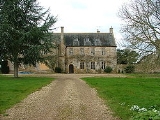
Tintinhull Court
Encyclopedia
Tintinhull Court in Tintinhull
, Somerset
, England was built as a medieval parsonage for the Church of St Margaret
. It has been designated as a Grade I listed building.
The Hamstone
building was re-modelled in 1678, 1777 and 1927, with the first of these being by the prior of nearby Montacute Priory
. After the dissolution of the monasteries
it became crown property belonging to Henry VIII who sold it to Sir William Petre
who sold it in 1546 to the Napper family who owned it for the next 250 years from their purchase of it in 1546. During the 17th century they built Tintinhull House
as a Dower House
.
In 2009 the house for sale with an asking price of around £2million.
Tintinhull
This article is about a village in England. For the Australian village, see Tintinhull, New South Wales.Tintinhull is a village and civil parish close to the A303 near Yeovil, south west of Ilchester, in Somerset, England...
, Somerset
Somerset
The ceremonial and non-metropolitan county of Somerset in South West England borders Bristol and Gloucestershire to the north, Wiltshire to the east, Dorset to the south-east, and Devon to the south-west. It is partly bounded to the north and west by the Bristol Channel and the estuary of the...
, England was built as a medieval parsonage for the Church of St Margaret
Church of St Margaret, Tintinhull
The Church of St Margaret in Tintinhull, Somerset, England dates from the 13th century and has been designated as a Grade I listed building.There was a chu8rch in the village during the 12th century which was replaced by the present building...
. It has been designated as a Grade I listed building.
The Hamstone
Hamstone
Hamstone is the colloquial name given to stone from Ham Hill, Somerset, England. Hamstone is a Jurassic limestone from the Toarcian, or Upper Lias, stage. It is a well cemented medium to coarse grained limestone characterised by its honey-gold colour and marked bedding planes. The stone contains...
building was re-modelled in 1678, 1777 and 1927, with the first of these being by the prior of nearby Montacute Priory
Montacute Priory
Montacute Priory was a Cluniac priory of the Benedictine order in Montacute, Somerset, England, founded between 1078 and 1102 by William, Count of Mortain, in face of a threat that if he did not do so, the King would take the land from him. It was the only Somerset dependency of Cluny Abbey until...
. After the dissolution of the monasteries
Dissolution of the Monasteries
The Dissolution of the Monasteries, sometimes referred to as the Suppression of the Monasteries, was the set of administrative and legal processes between 1536 and 1541 by which Henry VIII disbanded monasteries, priories, convents and friaries in England, Wales and Ireland; appropriated their...
it became crown property belonging to Henry VIII who sold it to Sir William Petre
William Petre
Sir William Petre was a secretary of state to Henry VIII, Edward VI, Mary I and Elizabeth I.Educated as a lawyer at Oxford, he became a public servant, probably through the influence of the Boleyns, one of whom, George, he had tutored at Oxford and another of whom, Anne, was married to the king...
who sold it in 1546 to the Napper family who owned it for the next 250 years from their purchase of it in 1546. During the 17th century they built Tintinhull House
Tintinhull Garden
Tintinhull Garden, located in Tintinhull, Yeovil, Somerset, England is a small 20th century Arts and Crafts garden surrounding a 17th century house. The property is in the ownership of the National Trust.-House:...
as a Dower House
Dower house
On an estate, a dower house is usually a moderately large house available for use by the widow of the estate-owner. The widow, often known as the "dowager" usually moves into the dower house from the larger family house on the death of her husband if the heir is married, and upon his marriage if he...
.
In 2009 the house for sale with an asking price of around £2million.

